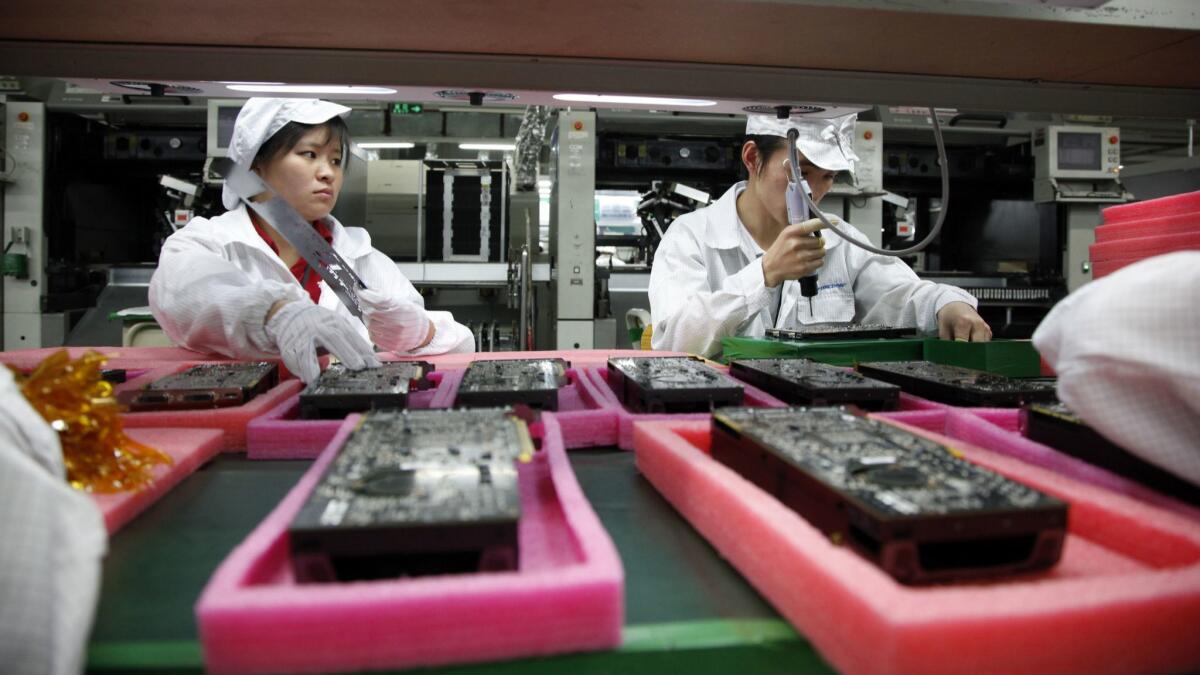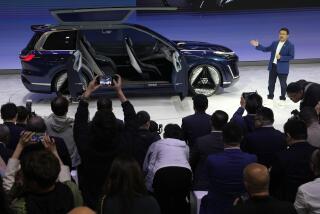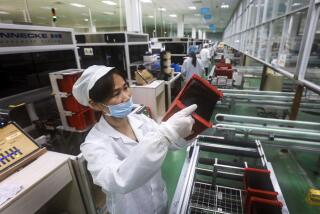Apple’s China tariff trade-off: raise iPhone prices or watch profit margins drop

For more than a year, Apple Inc. avoided major damage from the U.S. trade war with China, thanks in part to a White House charm offensive by Chief Executive Officer Tim Cook. But the company now faces its first major hit — from both sides of the dispute.
A new round of tariffs proposed by the U.S. on Monday — which would go into effect in late June, at the earliest — includes mobile phones. That means the iPhone, Apple’s most important product that is made almost entirely in China, may be encumbered with a 25% import levy. There are other products on the list that would affect Apple too, such as laptops and tablets.
That leaves the company with a difficult choice: Raise prices on already-pricey products and risk missing out on sales, or absorb the extra cost and let profits suffer.
There’s a “very real risk of higher import costs and/or U.S. consumer demand destruction depending on whether Apple decides to pass along some of the tariff cost,” Krish Sankar, an analyst at Cowen Inc., wrote Tuesday in a note to investors. “Given that the majority of Apple’s hardware products that include the iPhone, iPad, Watch, and Mac systems are assembled and imported from China, the earnings risk could be quite substantial.”
China retaliated Monday with plans to increase tariffs on U.S. imports to 25% from 10%. That would apply to components for the iPad and iPhone. So when U.S.-made parts including glass screen covers and facial-recognition sensors are shipped to China for assembly into iPhones and iPads, they will be more expensive too.
The main concern is the iPhone, though. It accounted for 63% of sales in 2018, and serves as a hub for additional revenue from services and related devices like the Apple Watch. The newest iPhones cost $750 to $1,450, so any price increases could take the devices beyond the budgets of more consumers.
The heightened trade tensions are a test for Cook and the global supply chain he helped build and run. Last year, the CEO showed political prowess by meeting with President Trump to argue against tariffs.
Just over a year ago, Cook met Trump in the Oval Office. The CEO said he opposed the president’s approach and focused on how cooperation between countries can boost the economy more than nations acting alone. After the meeting, the administration told Cook it would not place tariffs on iPhones, the New York Times reported.
Apple also wrote to U.S. Trade Representative Robert Lighthizer in September asking him to reconsider tariffs and instead take other measures that would support the U.S. economy and American consumers. Later that month, the White House spared Apple’s Watch and AirPods.
By late 2018, Apple’s strategy had become less effective. In late November, Trump told the Wall Street Journal he might impose tariffs on mobile phones and laptops, and said consumers “could stand” a 10% increase in prices “very easily.” The day after, Cook toured schools in Idaho with Ivanka Trump, the president’s daughter and senior advisor.
As 2019 began, the real cost of the trade war for Apple began to emerge. The company cut revenue projections and Cook said the Trump administration’s trade policies had indirectly hurt consumer demand for iPhones in China.
More recently, the company has raised prices when it refreshed products that have already been hit with tariffs. The updated Apple Pencil, launched in October, costs $30 more than the previous version. The faster Mac mini costs $300 more than its predecessor.
That suggests the company may take a similar approach with the iPhone. In its September letter to Lighthizer, Apple said tariffs would increase product prices.
The 25% tariff on iPhones would likely apply to the wholesale price of the devices when they are imported from China. Apple doesn’t disclose wholesale prices, but research firms often estimate the bill of materials.
A $1,249 iPhone XS Max with 256 gigabytes of storage has $453 worth of parts, according to TechInsights. A 25% levy on that would be $113, raising the purchase price by about 9%. Apple’s other models, the iPhone XS and the iPhone XR, could face a similar increase, according to estimates. In a recent note to investors, Morgan Stanley estimated that a $999 iPhone XS would cost $160 more. JPMorgan analysts forecast a 14% price increase.
This may only apply to U.S. iPhone sales, limiting the damage. About a third of iPhone revenue comes from the U.S., according to Shannon Cross of Cross Research.
That won’t address the problem of even more expensive iPhones, though. A series of price increases in recent years has already coincided with declining sales. If Apple passes the whole tariff cost to U.S. consumers, demand could drop by 10% to 40%, Cowen’s Sankar estimated on Tuesday. That, in turn, may slice earnings per share by 1% to 4% in fiscal 2020, the analyst said.
Alternatively, Apple could eat the cost and leave iPhone prices untouched. That would dent earnings per share by 6% to 7%, based on a $450-per-device import cost and annual U.S. unit sales of 40 million, according to Sankar.
Still, Apple has experience absorbing extra costs. When currencies swing, the company manages to protect its gross profit margins, Cross noted.
Apple could work around the tariff issue as well. There’s a possibility of Apple rejiggering its supply chain to build more products outside China. Apple is ramping up production in India to avoid local taxes and has done similar work with Foxconn in Brazil.
More to Read
Inside the business of entertainment
The Wide Shot brings you news, analysis and insights on everything from streaming wars to production — and what it all means for the future.
You may occasionally receive promotional content from the Los Angeles Times.










